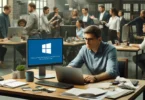Aussi, il y a 2 plus de dossiers dont je ne sais pas ce que c'est: WpSystem et WUDownloadCache. Sont-ils liés à Windows ou puis-je simplement le supprimer? Et un “Fichiers programme” dossier, toujours en D:, mais je suppose que c'est pour un programme que je pourrais installer sur D:, Je ne pense pas l'avoir fait, d'ailleurs. Le 4 dossiers (Applications Windows, Systèmes Wp, WUDéléchargerCache, et fichiers de programmes) en D: sont 0 octets en taille, et C: et D: sont 2 différents SSD. Quelqu'un peut-il me dire quoi faire dans ce scénario? J'apprécierai votre aide.Utilisateur Reddit
Préparer une nouvelle installation de Windows 11 implique d’effacer les anciens fichiers pour assurer une transition en douceur et un nouveau départ. Parmi ceux-ci, le dossier WindowsApps sur votre D: conduire, avec d'autres dossiers système comme WpSystem et WUDownloadCache, pourrait poser des questions quant à savoir s’ils doivent être conservés ou supprimés. Voici un guide étape par étape pour gérer ces dossiers avant de procéder à Windows 11 réinstaller.
Comprendre les dossiers
Applications Windows: Ce dossier contient la plateforme Windows universelle (UWP) applications téléchargées depuis le Microsoft Store. Il est généralement protégé pour des raisons de sécurité, ce qui rend l'accès direct et la modification difficiles.
WpSystem et WUDownloadCache: Ces dossiers sont utilisés par le système d'exploitation Windows pour les mises à jour et les fichiers temporaires. WpSystem est souvent lié aux données de l'application UWP, tandis que WUDownloadCache stocke les fichiers temporaires des mises à jour Windows.
Fichiers programme: Ce répertoire peut exister sur votre D: conduire si vous y avez installé des applications. C'est similaire au dossier Program Files sur votre C: lecteur mais pour les logiciels explicitement destinés à être installés sur D:.
Étapes pour supprimer ces dossiers en toute sécurité
- Sauvegarder les données importantes: Avant d'apporter des modifications, assurez-vous d'avoir sauvegardé tous les fichiers ou données importants de ces dossiers si possible.
- Accéder: Pour supprimer le dossier WindowsApps, vous devrez peut-être vous en approprier. Right-click the folder > Properties > Security Tab > Advanced > Change (à côté du propriétaire) > Enter your user name > Check Names > OK > Apply > OK.
- Supprimer les dossiers: Une fois que vous en êtes propriétaire, tu devrais pouvoir supprimer le dossier. Si Windows empêche la suppression car le dossier est en cours d'utilisation, essayez de démarrer en mode sans échec et tentez à nouveau la suppression.
- Utiliser le nettoyage de disque: Pour les utilisateurs moins techniques, exécuter le nettoyage de disque sur le D: le lecteur peut aider à supprimer les fichiers inutiles sans supprimer manuellement les dossiers système.
Note: Les dossiers WpSystem et WUDownloadCache peuvent généralement être supprimés sans en devenir propriétaire, mais assurez-vous qu'ils ne sont pas utilisés par Windows au moment de la suppression.
Après l'installation propre
Suite à une nouvelle installation de Windows 11, tu auras une table rase. Tous les dossiers système nécessaires seront recréés sur le C: conduire. Si vous utilisez le D: lecteur pour le stockage ou les applications, vous pouvez recréer manuellement tous les répertoires requis, garder votre système organisé et exempt de tout encombrement résiduel de l'installation précédente.
Conclusion
Nettoyer les anciens dossiers système, y compris les applications Windows, à partir d'un lecteur secondaire comme D: avant de réinstaller Windows peut aider à garantir un environnement propre pour votre nouvelle installation. Ce processus, bien qu'un peu technique, peut libérer de l'espace et réduire les conflits potentiels avec votre nouveau Windows 11 installation. N'oubliez jamais de sauvegarder les données importantes avant de procéder à ces étapes.








Laissez un commentaire